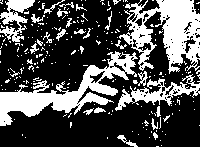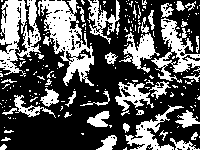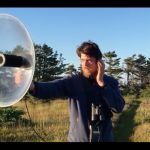Reaching into a hole in the ground and pulling out a fuzzy, chattering bird perhaps 10 years your senior is all part of the decades-long study of storm-petrels at the Bowdoin Scientific Station on Kent Island in the Bay of Fundy. Read why Liam Taylor ’17 loves it, as told by Emily Weyrauch ’17 in the latest installment of her series on Kent Island life.
 Face contorting as he sticks his right arm deeper into the earthy hole, a dirt-covered researcher pushes his body against the mossy ground to gain the extra centimeter or so of length he needs to grasp the creature inside. Within minutes Liam Taylor ’17 gently pulls out a small, dark gray bird and holds it calmly in his hand, ready to take measurements and check its band number.
Face contorting as he sticks his right arm deeper into the earthy hole, a dirt-covered researcher pushes his body against the mossy ground to gain the extra centimeter or so of length he needs to grasp the creature inside. Within minutes Liam Taylor ’17 gently pulls out a small, dark gray bird and holds it calmly in his hand, ready to take measurements and check its band number.
Taylor and Kenyon College students Lauren Michael ’17 and Sarah Adrianowycz ’16 are grubbing for Leach’s storm-petrels, long-lived seabirds that burrow in the ground to nest, a process that involves reaching into burrows to determine occupancy and to temporarily remove a bird for measurements.
The students are continuing a 62-year long study of the species at the Bowdoin Scientific Station (BSS) at Kent Island, taking measurements and monitoring egg hatching and chick growth with the help of their advisor, former BSS Director Robert Mauck who currently teaches at Kenyon.

Adrianowycz measures a Leach’s storm-petrel egg after carefully removing it from a burrow.
Taylor and Adrianowycz both worked on the petrel project at BSS last summer, and Michael is new to the group.
“Team Petrel, as we have taken to calling ourselves, is very efficient when it needs to be,” said Adrianowycz, “which is really good, because it can be an insane amount of work.”
Every day, regardless of weather conditions, the three students go out to their study site to collect data for the long-term storm-petrel research started by Bowdoin Professor Chuck Huntington in 1953.
The Leach’s storm-petrel study at BSS-Kent Island is one of the longest-running longitudinal studies of any wild population of animals, and has resulted in the publication of over 60 scientific papers.
“We’ve found the burrows; we’ve got histories of them, you don’t have to go out searching,” said Mauck. “It’s all there, ready to go, and we’ve got long-term information on them, so there are always new questions we can ask and new things we can do.”
Because the research is long-term, the students work on updating the database of information and measurements that can be used to answer current scientific questions and those that may arise in the future.
“That scientific effort is going to end up being a really valuable tool,” said Taylor. “If this goes on for another decade or two decades, you’ll be able to look at the effects of climate change on the nesting habitat of Leach’s storm-petrel.”
- Liam Taylor ’17 holds a Leach’s storm-petrel. This is his second summer working with the petrels on Kent Island.
- Michael takes measurements of a Leach’s storm petrel in the area of Kent Island that they dub ‘The Shire.”
The storm-petrels weigh less than two ounces and are about the size of a robin but with much longer wings. They can live up to 36 years, a longevity that is unusual for a bird of such small size, which adds to the importance of their long-term monitoring on Kent Island.
“That’s the weirdest thing—the cognitive dissonance for me is when I stick my hand in a hole and I pull out a bird and I’m like, ‘you could be older than me,’” said Adrianowycz. “This bird was around having chicks before I was even alive. It’s a very strange thing to think about. I enjoy it.”
The students demonstrate a fondness for their selected study species.
“They’re fuzzy, and they’re chattery, and they smell funny, and you kind of feel for them,” said Taylor.
“If you’re sticking your hand in a hole, you expect to find like a slug or a worm and the last thing you expect to find is like this fuzzy little creature that just kind of looks at you,” said Adrianowycz.
“Putting your hand in a hole and then feeling the little bird nibbling on you and then pulling it out—it’s such a surreal experience,” said Michael. “It’s really fun.”
Added Adrianowycz, “I really enjoy the physicality of it.”
The students are working on their own independent projects with the storm-petrels in addition to the long-term demography study.
Adrianowycz is continuing her project from last year and attaching geolocators — tiny tracking devices that use light levels to determine location — to storm-petrels in order to track their movements during foraging trips, in particular as they correspond to parent sex. She is using this research for her honors thesis at Kenyon.
Taylor is using PIT tags — passive integrated transponders — to track adult birds’ arrivals at and departures from their burrows. He is looking into which parent cares for the egg at what time, and how the parents coordinate
 Michael is taking additional measurements to try to determine symmetry or asymmetry in the birds. When many organisms are under environmental distress, they become asymmetric rather then symmetrical, and Michael is testing how storm-petrel asymmetry links with differential reproductive success.
Michael is taking additional measurements to try to determine symmetry or asymmetry in the birds. When many organisms are under environmental distress, they become asymmetric rather then symmetrical, and Michael is testing how storm-petrel asymmetry links with differential reproductive success.
“It’s really nice because a lot of these things are really hard to do alone, so basically we all work together and then analyze our data differently,” said Michael, “so we all have a part in everyone’s project.”
Working at the BSS with a variety of other ecological and avian researchers has its advantages.
“It’s cool to be here part of a group, especially with other scientists who are interested in birds, because they can give you a new perspective,” said Adrianowycz.
All three students hope to continue scientific research in the future.
“I think it’s a wonderful experience,” said Mauck, who himself has spent many summers on Kent Island, “getting to do science in the field, and living in a field station that is different from most of the others.”
“It’s a lot of fun. I don’t know quite how to explain why it’s so fun,” said Michael. “You never know quite what’s going to happen or when it’s going to start pouring rain. It’s just kind of always an adventure being out there.”


